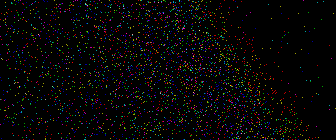Beneath the sun a 22-degree halo curves across the snow. It has a distinct reddish inner edge and inside there are markedly fewer glints of light. At far left is perhaps a hint of the huge 46-degree bow. Ground halos are subtle and are best seen while walking or moving your head.
The halos are produced by refraction through hexagonal prism ice crystals (rather than more effete snow crystals) tumbled in random orientations on the ground.
The large scale view (below) allows us to see the individual rays and glints that make up the 22� halo, something we cannot do when it is in the sky unless the halo is part of an intense and nearby diamond dust display. The halo inner rim is made up of red glints but reds are not limited to the rim. They extend far out to the left edge of the photograph. Similarly there is a circle of blue glints slightly beyond the halo inner rim and the blues also extend far outwards.
The 22� halo is a minimum deviation effect. Rays passing through the hexagonal crystals are deviated through a minimum angle of 22� but a great many rays are refracted through greater angles. The minimum deviation angle for blue light is slightly greater than that for reds and consequently the blue halo is slightly larger and allows a red rim to show inside it.
At greater angles all the colours overlap and we see a white glow or an apparent lightening of the sky. But on the ground we can still see all the individual coloured sparkles that craft the halo. The HaloSim ray tracing at lower right reproduces the effect. However, next time you are on old snow where the ice crystals have grown overnight look carefully at the glints to see Nature�s own halo ray tracing at work.
|











